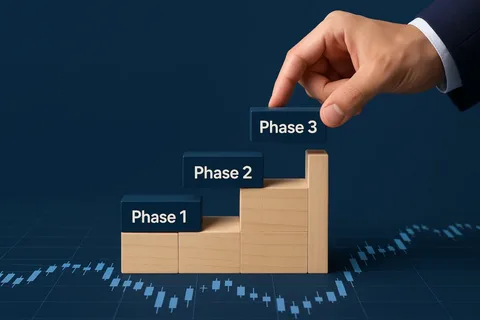S&P 500 remains one of the most powerful indicators in the financial markets. It is a composite of the 500 largest companies listed on American stock exchanges, and its projection is holistic and definitive in regards to the market. For those who need exposure to this index without wishing to purchase all of these stocks individually, S&P 500 futures contracts are a cheap and efficient option. The following book is an overview of how to invest in S&P 500 futures and how to most effectively select the optimum futures trading platform for your strategies and delivery.
Learning About S&P 500 Futures
S&P 500 futures are contracts that symbolize the worth of the S&P 500 index. They facilitate speculation on or hedging against index movement without the requirement to purchase any of the underlying index stocks. Contrary to conventional investment, in which the quantum of capital may be prohibitive, futures trading demands only a fraction of the notional value in margin, thereby permitting less capital to be utilized to gain exposure to extensive markets. There are a number of S&P 500 futures contracts that one may trade but the most liquid among these are the Micro E-mini and the E-mini S&P 500. The E-mini is preferred since it has high liquidity and volume but the Micro E-mini provides more nuanced position sizing and lower capital outlay and is suited for newer and conservative traders.
How to Invest in S&P 500
Trading mechanics of S&P 500 futures begin with the trading mechanics of the futures market. Each futures contract has an expiration, a margin requirement, a tick size, and a point value. When entering a position, the trader goes long and buys or goes short and sells a contract based on their view of the market. The profit or loss is taken where the contract price differs from where the position was entered. Strength of futures is that selling or buying long is also feasible with the same facility, in increasing or decreasing market directions. Two-way facility gives a strength of futures to other instruments to such traders who want flexibility for any type of market condition. Trade sizing should be adequate. Based on the trader’s capital, future risk tolerance, and type of trading, Micro or E-mini contracts would be the better option either way. Leverage must still be considered though since the higher exposure also has huge gains or losses from comparatively small price movement of the index.
Strategy Design and Execution
Profit from futures trading is achieved through well-designed plan, faithful follow-through, and good risk management. Technical, macroeconomic, or a combination of both approaches are available to implement in S&P 500 futures trading. Trend-following systems employing moving averages, breakouts in price level, and mean reversion strategies based on short-term price inefficiencies are also common technical approaches typically utilized. Relative Strength Index (RSI), MACD, or Bollinger Bands are also utilized by traders as entry and exit instruments. Macro or foundational strategies would consider news releases of economic announcements, central bank releases, or political events to predict overall market action. Merging technical and macro perspectives will convert more trades into accuracy and volume. Backtesting is the initial step in implementing any strategy. Backtesting means to practice your trading concept using the past data to see how it would have worked. It helps one to define the strengths, weaknesses, and areas for development.
Risk Management Principles
Since futures are leveraged contracts, risk management is an absolute requirement—never optional. Each trade needs a prior risk assessment, i.e., determining maximum acceptable loss, stop-loss amount, and proper right size of contract. Position size needs to be relative to the trader’s account equity and risk levels. Never over-lever, especially during volatile periods. Utilize stop-loss orders judiciously to contain downside risk and to enable disciplined unwinding. Track the overall portfolio exposure, particularly when there are multiple positions. Watch out for cross-asset or intra-market correlation that can cause risk inadvertently. Dynamic reversal of exposure with the account performance is another very applicable technique—get long on winning intervals and tighten during drawdowns. Maintain a trading journal of trades, methods, outcomes, and emotional responses. It is then a useful thinking and improvement instrument after some time passes.
Best Futures Trading Platform
The best futures trading platform should also be chosen in order to make efficient trades, manage risk, and conduct analytical surveillance of market action. The best platform would have to provide real-time market data, high-performance order-execution ability, and intrinsic analytic ability. The platform must have customizable charts, technical indicators, and backtesting of the trading system so that the traders will be able to make rational trading decisions based on the data. Various orders like market, limit, stop, and OCO orders need to be available in the platform so that the trader has a choice to handle the trade in whatever manner he is comfortable with. Good trading platform should also include performance monitoring facility, journaling facility, and risk facilities like real-time margin monitoring and loss limits. Simulation environments are very useful since they allow the trader to practice in environments closest to the live market. It gives confidence, sharpens execution, and prevents costly mistakes when moving to live capital.
Conclusion
Mastering the skill of S&P 500 futures investing is a task that requires market intelligence, strategy, risk control, and the appropriate tools. Futures offer an easy, capital-saving way to gain access to the S&P 500 index, with the bonus of having the ability to short sell and buy long viewpoints. In either Micro or E-mini contracts, one can ride with the market highs and lows with precision and finesse. Preparation is key to effective futures trading. Create a good plan, test aggressively, and rigidly adhere to it. Equipped with the finest futures trading platform to offer the data, execution, analysis, and risk management required for optimal performance, the S&P 500 futures market can be a formidable weapon for astute traders to leverage one of the world’s finest indexes with the proper strategy and mindset.

